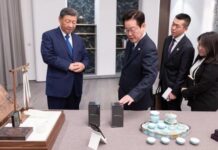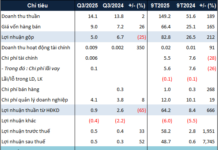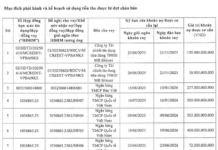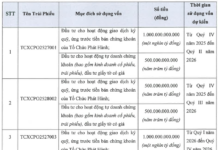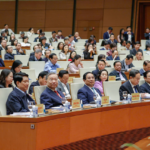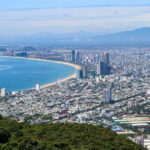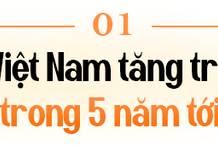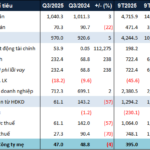
The conference was connected to 14,535 online meeting points nationwide, with over 1.3 million delegates in attendance – Photo: VGP/Nhật Bắc
The conference was attended by: General Secretary Tô Lâm; President Lương Cường; Prime Minister Phạm Minh Chính; Chairman of the National Assembly Trần Thanh Mẫn; Standing Member of the Secretariat, Chairman of the Central Inspection Commission Trần Cẩm Tú; Politburo members, Secretariat members; leaders of ministries, sectors…
The conference was connected to 14,535 online meeting points nationwide, with over 1.3 million delegates in attendance.
As scheduled, at the conference, Politburo member, Secretary of the Central Party Committee, and Head of the Central Organization Commission Lê Minh Hưng conveyed the main contents and focus of the implementation of Resolution No. 18-NQ/TW of the 12th Party Central Committee.
Politburo member and Chairman of the National Assembly Trần Thanh Mẫn conveyed the topic “Unblocking the bottlenecks and knots in the institutional mechanism.”
Politburo member and Prime Minister Phạm Minh Chính conveyed the topic “Report on socio-economic situation in 2024 and solutions to accelerate socio-economic development in 2025.”
General Secretary of the Central Committee of the Communist Party of Vietnam Tô Lâm gave directives at the conference.
Politburo member, Secretary of the Central Party Committee, and Head of the Central Propaganda and Education Commission Nguyễn Trọng Nghĩa gave guidance on propaganda work regarding the conference’s contents.
Regarding the implementation of Resolution No. 18-NQ/TW dated October 25, 2017, of the 12th Party Central Committee, “Some issues on continuing to renew and rearrange the organizational structure of the political system towards being streamlined and operating effectively and efficiently,” Head of the Central Organization Commission Lê Minh Hưng stated that after seven years of implementation, with the efforts and high determination of the Central Committee, the Party committees, organizations, and especially the leaders, the organization and implementation of Resolution 18-NQ/TW have achieved important results, initially creating positive changes in renewing and rearranging the organizational structure and improving the effectiveness and efficiency of the agencies, units, and organizations within the political system.

Politburo member, Secretary of the Central Party Committee, and Head of the Central Organization Commission Lê Minh Hưng conveyed the main contents and focus of the implementation of Resolution No. 18-NQ/TW of the 12th Party Central Committee – Photo: VGP/Nhật Bắc
However, the rearrangement of the organizational structure has not been synchronized and lacks a holistic approach. It has not been associated with streamlining the personnel apparatus and restructuring and improving the quality of the contingent of officials, public employees, and employees. The political system’s organizational structure remains cumbersome, with many layers and branches; the functions, tasks, powers, and working relationships of many agencies, units, and organizations are still unclear and overlapping. Decentralization and empowerment of localities have not been strong, consistent, or reasonable, failing to meet the requirements and tasks of the new period…
The main reason is that the overall organizational model of the political system is not yet perfect; the awareness and actions of Party committees, Party organizations, leaders, and heads of some agencies, organizations, units, and localities are not yet comprehensive, profound, or determined enough, and their actions lack resoluteness.
Given the requirements and tasks of the new development period as the country enters a new era, the Party Central Committee and the Politburo have agreed with strong political determination to implement the early and comprehensive summing up of Resolution 18-NQ/TW throughout the political system.
The Politburo determined that summing up Resolution 18-NQ/TW and rearranging and perfecting the organizational structure of the political system towards being streamlined and operating effectively and efficiently is an extremely important task and a revolution in streamlining the political system’s organizational structure. It requires a high level of consensus in awareness and action within the entire Party and political system.
Party committees, Party organizations, agencies, units, levels, and sectors, first and foremost the leaders and heads, need to be exemplary, proactive, and determined to implement this task in the spirit of “running while arranging” and “the Central Committee does not wait for the provinces, the provinces do not wait for the districts, and the districts do not wait for the grassroots.” It is necessary to identify priorities and coordinate smoothly in implementation, determined to complete the streamlining of the political system’s organizational structure according to the set goals, requirements, and progress.
The summing up must be conducted objectively, democratically, scientifically, and pragmatically, with a sense of urgency. It should thoroughly evaluate the situation and achievements, clearly identify shortcomings and limitations, and their causes, and propose to the Politburo and the Party Central Committee on directions, tasks, and solutions to continue renewing and rearranging the organizational structure of the political system towards being streamlined, energetic, effective, and efficient, ensuring comprehensiveness, synergy, and connectivity.
Strictly adhere to the principle of “one agency performing multiple tasks” and “one task assigned to one agency as the main responsible entity.” Completely overcome the overlapping of functions and tasks and the division of areas and fields. Even agencies and organizations that have been initially arranged need to be reviewed and proposed again; resolutely eliminate intermediary organizations.
Organizational restructuring must be associated with the thorough and effective implementation of the directions on renewing the leadership method and enhancing the leadership and ruling capacity of the Party, strong decentralization and empowerment for localities, anti-wastefulness, national digital transformation, and socialization of public services…, in conjunction with restructuring and improving the quality of the contingent of officials, public employees, and employees to ensure their morality and capacity, meeting the requirements of the new period. The new apparatus must be better than the old one and must start operating immediately, without interrupting work, leaving time gaps, or creating voids in areas and fields, and without affecting the normal activities of society and the people…
The Merger Option to Reduce at Least Five Ministries
The proposal to streamline and reorganize Vietnam’s political system was put forward by Le Minh Hung, Head of the Central Organization Commission. The plan includes a reduction of at least five ministries, with a focus on creating a more efficient and effective government structure.
Unlocking Southern Escape: A Half-Trillion Dong Investment to the Rescue
The Rach Dia Bridge, connecting District 7 and Nha Be District in Ho Chi Minh City, officially opened to traffic this morning, November 28, a month ahead of schedule. This infrastructure project is set to improve the traffic situation in the area, reduce congestion, and boost socioeconomic development in southern Ho Chi Minh City.
Unlocking New Frontiers: TS Can Van Luc on Da Nang’s Need for Fresh Expansion
“The development of a Free Trade Area is a strategic move to create room for growth and diversify Danang’s economy, according to Dr. Can Van Luc, Member of the Monetary and Financial Policy Advisory Council. This zone presents an opportunity to integrate multiple functions, such as establishing a financial hub, a digital economic cluster, investing in iconic infrastructure projects, and promoting high-end tourism and services.”
Economic Growth Surges in Provincial Town, Soaring to 23.8% with Over $1.2 Billion in Registered Investment
The socio-economic and defense-security situation in Quang Yen town in 2024 demonstrated comprehensive development, with many targets not only achieved but surpassed.

